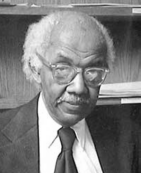 Today is the Feast Day of Blessed Allan Rohan Crite.[i]
Today is the Feast Day of Blessed Allan Rohan Crite.[i]
He was an Anglo Catholic, African American artist. He died on this day in 2007.
I think Allan Crite[ii] was possibly the most significant artist of the Episcopal Church in the past 100 years. One of his gifts was an ability to illustrate a relationship between worship in heaven and the Anglo Catholic mass. It was as though for him a high solemn Eucharist, or possibly a quiet mid-week Mass, came as close as humanity can come to the worship of heaven – graceful, glorious, beautiful, joyful, enchanting—worship that takes your breath away or brings you to the still place within. Solemn joy. Worship that centers and grounds, that sustains and nurtures human dignity. Worship “to make music in the heart.”[iii] Crite captured all that in his art.
He also did something else in his work. He connected the African American experience with Christian Faith and Episcopal liturgy.
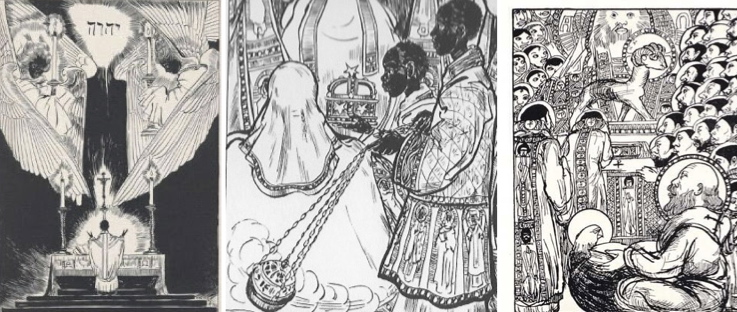
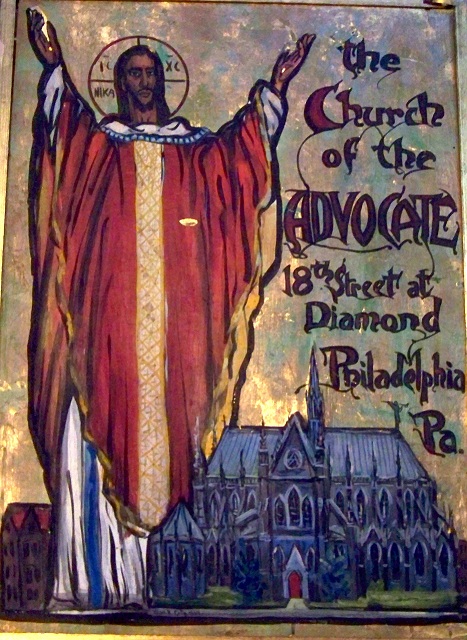 My first exposure to Allan Crite’s work was at the Church of the Advocate in Philadelphia around 1964 or 65. He was producing the front of the Sunday bulletin each week. He did that for several parishes.[iv] The parish also had Stations of the Cross he had done and a banner of Christ standing by the church building. Years later friends gave me a copy of his 1948 “Three Spirituals” and a print he did on the theme of Saint John the Evangelist.
My first exposure to Allan Crite’s work was at the Church of the Advocate in Philadelphia around 1964 or 65. He was producing the front of the Sunday bulletin each week. He did that for several parishes.[iv] The parish also had Stations of the Cross he had done and a banner of Christ standing by the church building. Years later friends gave me a copy of his 1948 “Three Spirituals” and a print he did on the theme of Saint John the Evangelist.
The Compassion & Justice Award
In 1988 Crite produced an image of Christ as the High Priest holding the bread and chalice in the midst of the City of Trenton (NJ). He made 244 copies for Saint Michael’s Church. We sold the prints to develop a small fund that was used to offer a Compassion and Justice Award each year. The person or group receiving the award was given one of the prints and $1000.
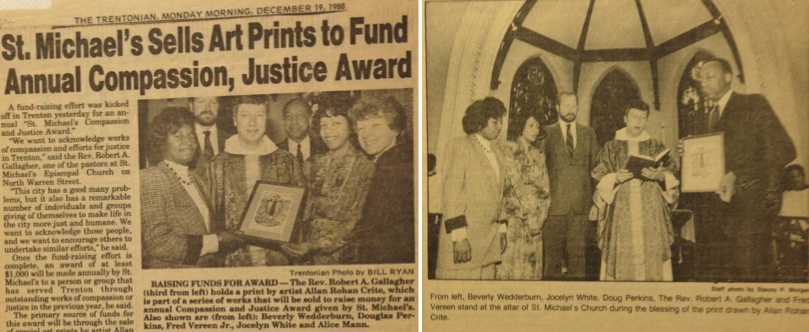
Allan Crite’s art seemed to be a perfect fit with the award. An article in the National Catholic Reporter, “Allan Crite had a profound sense of our common humanity, a lived philosophy that evokes the Pauline language of the Mystical Body of Christ. ‘We are part of each other. So anything that happens to any part of us, we all feel. But the thing is, we think that we’re doing something to somebody ‘over there’ who’s different from me,’ he said. ‘Actually what we’re doing is doing something to ourselves through that person. So if we do an injury to that particular person, we’re hurting. And if something happens to that particular person, we feel it. That probably accounts for, you might say, the extreme and sharp pain that a lot of us feel. We’re thinking we’re doing to somebody else, but it’s happening to us. That, in my opinion, is the real tragedy.’”
Later I moved over to another part of the city to become Vicar of Saint Andrew’s. The parish had within it a Eucharistic community that gathered at 9:30 on Sunday, the Community of Julian of Norwich. That community began to give it’s own Compassion and Justice Award. Sadly we had no Allan Crite print to offer. What we began to do there was to offer a $1000 award and also to work with contacts we had with the local paper, The Trenton Times, to run a full-page article about the organization or person receiving the award.

Later the parish became St. Peter’s IGBO Church an Organized Mission of the diocese.
The following is lifted from “Fill All Things: The Spiritual Dynamics of the Parish Church.”
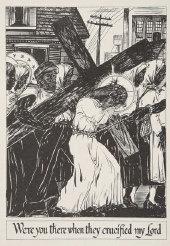 A Compassion & Justice Award. The parish gives a yearly award to a person or group in the region that has done outstanding work for compassion and/or justice in the past year. This allows the parish to point to, and affirm, the efforts already going on in the community. The award might include three elements: 1) A print done by a local artist that expresses the theme and has a small plaque on the frame noting the award and date. One urban parish made use of Alan Crite’s work. The Boston African-American artist was known for creating drawings of a Risen Christ among the people of the city. Often he would include a small image of the parish. 2) A financial award of a couple of thousand dollars, enough to be meaningful and within the means of most parishes. The check is given to the person or group to be used in any way they think best. 3) Arranging for a newspaper article about the award. The news release and “pitch” to the reporter would focus on the work of the award recipient rather than the parish. p 78 Section on the "Organic Nature of Christian Action" This section included examples of sustainable and useful justice-related activities in parishes.
A Compassion & Justice Award. The parish gives a yearly award to a person or group in the region that has done outstanding work for compassion and/or justice in the past year. This allows the parish to point to, and affirm, the efforts already going on in the community. The award might include three elements: 1) A print done by a local artist that expresses the theme and has a small plaque on the frame noting the award and date. One urban parish made use of Alan Crite’s work. The Boston African-American artist was known for creating drawings of a Risen Christ among the people of the city. Often he would include a small image of the parish. 2) A financial award of a couple of thousand dollars, enough to be meaningful and within the means of most parishes. The check is given to the person or group to be used in any way they think best. 3) Arranging for a newspaper article about the award. The news release and “pitch” to the reporter would focus on the work of the award recipient rather than the parish. p 78 Section on the "Organic Nature of Christian Action" This section included examples of sustainable and useful justice-related activities in parishes.
Most of us, most of the time, have a primary vocation in the arenas of our daily life. We are instruments of compassion and justice in our workplace, with family and friends, and in civic involvement. This is a process that is largely organic and subconscious. We are light and salt to the extent we have become light and salt. We are invited to love and serve in the places we find ourselves. The process isn’t at its core a matter of our planning and awareness; rather it is dependent on our status as people incorporated by baptism into the Body of Christ. It is living as an extension of the sacrament that is the Church in which God’s compassion and justice is offered through us in the routine and ordinary places of life. p. 22
Set aside the life of grumbling and loneliness and seek the life of community and solitude. Let go of anxiety about making members happy and serving their needs and turn instead toward making members holy and being a community of compassion and justice. p 72 section on "Developing a Healthy Parish"
 The organic relationship of holiness and Christian action was expressed by James Huntington, OHC. “Holiness is the brightness of divine love, and love is never idle; it must accomplish great things. Love must act as light must shine and fire must burn.”....This organic life of the Body can have more play in our institutional life as we contemplate what is already present in our life as a parish. Seek within the commitments and decisions of regular parish life opportunities for compassion and justice. This may allow us to see the lonely, grieving, and overburdened among us. It may help us give attention to the day-by-day decisions that relate to compassion and justice. We can use union contractors and union businesses, provide meeting space for groups working for compassion and justice, and be more environmentally responsible. p 80
The organic relationship of holiness and Christian action was expressed by James Huntington, OHC. “Holiness is the brightness of divine love, and love is never idle; it must accomplish great things. Love must act as light must shine and fire must burn.”....This organic life of the Body can have more play in our institutional life as we contemplate what is already present in our life as a parish. Seek within the commitments and decisions of regular parish life opportunities for compassion and justice. This may allow us to see the lonely, grieving, and overburdened among us. It may help us give attention to the day-by-day decisions that relate to compassion and justice. We can use union contractors and union businesses, provide meeting space for groups working for compassion and justice, and be more environmentally responsible. p 80
Here are some of the things that happened as we offered the award over the years.
- We saw how important it was for some of the recipients. It mattered to them that others noticed.
- Because we worked at getting news coverage for those receiving the award there was a multiplier effect. Others would contact them.
- Our approach with the newspaper of focusing on the recipient helped build trust with reporters. This wasn’t just another church trying to get their annual fair in the news.
- It caused a conversation within the parish community. Why not use the news coverage to get more coverage for the parish? Or for others, why not avoid having us mentioned at all?
- We developed relationships with a broad range of servers and advocates. We learned about our city through the eyes of others.
- We developed less compulsiveness about having to ourselves be a service center and a greater appreciation for what others are doing and how the baptized of the parish were instruments of compassion and justice in their daily lives.
- The awards and the news coverage reinforced the parish’s self understanding of its identity and moved others in the area to see us in that light.
Many parishes could offer such an award. It might be modified to fit the context.
- If in a large city it might not be possible to consistently arrange for news coverage that is citywide. Use the web, Face book, neighborhood methods of communication
- If a parish is more called to connect with the arts the award could be focused on that vocation.
rag+
[i] Well it’s not really his feast day on anyone’s calendar except mine. I just think it should be in the Church’s calendar. Here’s another person who has jumped ahead of the church regarding the Feast of Allan Crite
[ii] Interviews in 1979 and 1980 Oral history interview with Allan Rohan Crite, 1979 Jan. 16-1980 Oct. 22, Archives of American Art, Smithsonian Institution. The February 29, 1980 interview gives the most attention to his religious work—“ Through the liturgy, you see, events of the past are made a part of the present. The celebration of the Mass, etc. is a form of the drama. In that way the past is made present. Or you might say we are made part of an ever-growing congregation of people. All of that is behind us, behind these illustrations.” And “The spirituals are quite valid even today. The point of them was: they stressed the idea of a person's humanity within a system which denied that humanity. That happened to be the formal system of slavery. Today, we have a formal system of technology which does practically the same thing in many ways. It denies your human dignity. Something like spirituals are needed to reinforce the idea of the fact that we're human beings.” He also comments on his liturgical art in other interviews especially those of August 1980—“in the liturgical drawings -- those of the Mass, the story of the Way of the Cross, and so forth -- I was telling the story of man through a Black figure.” Also see -- "Artist as theologian" And in NCR “The spirit of the spiritual”
[iii] From “The Work of Christmas” by Howard Thurman (1926)
[iv] ALLAN ROHAN CRITE “Oh no, I'm always doing it. I'm doing these church bulletins, and [He laughs] that's a continuous operation and it ain't small! [Laughs again] I've been doing that for about 30 years, serving about six or seven parishes. Which means that continuously, maybe somewhere in the neighborhood of around 3- or 4- or 5,000 people are looking at the stuff every Sunday. I mean, that's a continuous operation.” From the interviews noted above. A page about the bulletins for St. Stephen’s and the Incarnation, DC